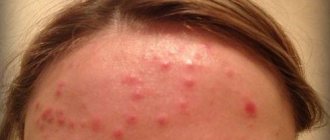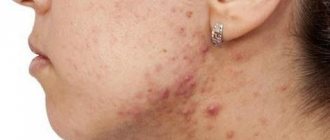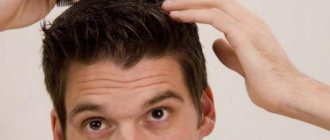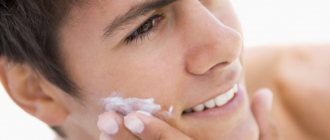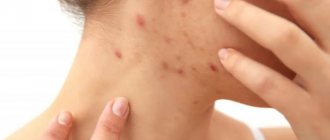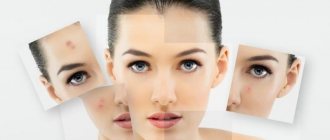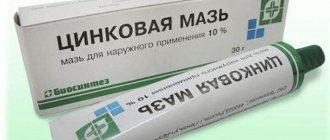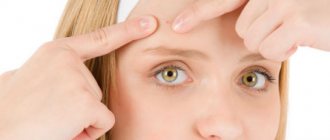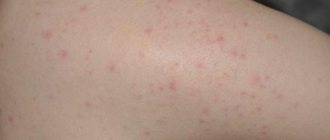Papular acne is the formation of papules on the skin, which are bumps with a hard consistency and a size of more than 1 centimeter. They are visible to the naked eye and can be felt under the finger when touched. Follicular lesions are mainly located on the facial skin in the T-zone, that is, on the forehead, nose and chin. This is an area of increased sebum and sebum production.
Papular acne is the most common and problematic form of acne. Treatment of papular acne requires medication and proper care.
Causes of formation of papular acne
The problem of papular acne mainly affects young people. In girls, this type of acne is usually more mild.
The changes that appear on the skin during the formation of papular acne are caused by the so-called hormonal storm. At a young age, hormone levels rise rapidly, causing the sebaceous glands to produce more sebum, which does not have time to be removed naturally.
Under physiological conditions, the production of sebum is necessary to create a protective layer on the skin that protects it from external factors. However, its excess, combined with exfoliating epidermis, sweat and dust from the environment, causes clogging of the sebaceous tubules and the appearance of acne, nodules and papules.
Bacteria multiply under the skin, and an inflammatory reaction develops, which is manifested by pain, pinpoint swelling and redness of the facial skin.
Papular acne in adults is caused by excessive stress, inadequate facial care, or problems with hormone (androgen) secretion. The most common problem of adult acne occurs in women, such as during menstruation or pregnancy. Papular changes are accompanied by pimples and acne.
Facial rashes: how to control them
If you have ever suffered from acne, you will no longer be careless in choosing cosmetics. One word “comedogenic” and the cream is forgotten forever. Regular struggle with blackheads - closed comedones, but before dates or important meetings, as luck would have it, an unpleasant surprise always pops up, and on critical days, pimples are generally a common thing.
There are a lot of remedies in your arsenal: pharmacy, cosmetic, folk remedies, but none of them eliminates the symptoms once and for all. Your friends advise you to take nutritional supplements and go to the solarium; you are frantically looking for a sane cosmetologist who can prolong the unstable remission. Is acne really never going to be cured?
This is wrong. Acne can be treated quite successfully. If you have a severe or moderate form of the disease (“moderate” acne), consult a cosmetologist, preferably a cosmetologist-dermatologist. Now there are many professional anti-acne lines. Be prepared for long-term treatment with uneven dynamics: after 2-3 sessions, temporary deterioration is possible, but this does not mean that the therapy was chosen incorrectly. You may be offered a combination of external therapy and tablets.
Dermatologists' methods will be stricter. There is a protocol (systematically developed recommendations) for treatment - this is a combination therapy: external agents and tetracycline antibiotics for several months. In my opinion, this option should be chosen only in severe cases, when there are multiple inflamed pustules, cystic formations, nodes, etc.
If you are past this stage and just want to control your breakouts, read on.
On store shelves there are a lot of products for home care for acne-prone skin. Every cosmetic company – no matter whether it is large, professional or “organic” – produces natural, organic products and has a special line for problem skin. Let's figure out how not to get lost in the variety of anti-acne products.
The four most common myths about the composition of cosmetic products:
Myth No. 1: Cosmetics are safe if they are labeled “non-comedogenic” or “non-acnegenic.”
The label “non-comedogenic” means that the product does not provoke the appearance of non-inflammatory open or closed comedones, known as blackheads and bumps/irregularities of the skin.
The term “comedogenicity” is not confirmed by law; it was invented by marketers to make cosmetic lines for minimizing and controlling acne seem reasonable, that is, to increase sales. But still, if a developer makes statements about the “non-comedogenicity” of his product, he is obliged to somehow confirm them.
In the best case scenario, the manufacturer tests its composition on the backs of volunteers whose skin is prone to clogged pores. If a cosmetic product does not increase the number of comedones, it is labeled as “non-comedogenic.”
For me, this is a very questionable study, primarily because the sebaceous glands of different locations have an unequal number of receptors that increase the production of sebum, which leads to comedones. Nevertheless, even such tests are still a plus, since an attempt is made to at least somehow substantiate the result. Basically, manufacturers simply quote the List of Non-Comedogenic Substances created by Dr. Kligman (who discovered cosmeceuticals for us) back in 1979, that is, there are no tests, just a naked theory.
The situation with tests for “acnegenicity” is approximately the same - they are very conditional.
Therefore, labels should not be trusted 100%. Myth No. 2. Mineral oil is comedogenic.
Many people believe that blackheads appear on them precisely because of the mineral oil included in the cosmetic product.
It is found in every second product, especially often in decorative cosmetics. Such statements are based on research from many years ago. Today there are many mineral oils: industrial - for lubricating mechanisms, cosmetic - the purest, without any impurities for cosmetics. And if the first can be comedogenic, then the second is not. Myth No. 3. Sunscreens - sunscreens - provoke acne.
This is almost true. Almost, because if inflammation appears 24–48 hours after applying the product, it is not acne, but irritation caused by sunscreen elements, mainly UV filters.
Acne is an immune response. And it takes weeks to trigger a response from the immune system.
Myth #4: Large pores associated with acne can be erased with makeup.
Only if you use so-called grouts - silicone-based products, which, when applied to enlarged pores, fill and smooth out all unevenness. The effect of the grout is purely visual and lasts until the first wash.
The size of the pores depends on the development and activity of the sebaceous glands: children do not have them, because the glands are not yet developed, but then what grows, grows. As you age, the activity of the glands decreases; after 60 years, your pores will be smaller.
Retinoids (substances analogues of vitamin A), which reduce sebum regulation, and regular cleansing, which pushes out sebaceous plugs, will help bring the pores to a natural state, but hoping to reduce their size is foolish.
Principles of self-diagnosis
We often tend to dramatize the situation and be too critical of our skin. A couple of pimples after fatty/sweet/salty foods or menstruation cannot even be called acne by any stretch of the imagination, especially with oily or combination skin types.
If you have fewer than 20 white-headed blackheads, fewer than 15 pustules, and fewer than 30 lesions in total, you have “mild” acne. Treatment usually takes up to 8 weeks with external remedies.
If you have 20 to 100 whiteheads, 15 to 50 inflamed bumps, and 30 to 125 breakouts in total, you have “moderate” acne. Treatment also takes several weeks and may briefly worsen during the process.
Moderate acne and more severe situations require consultation and professional treatment.
The dangers of self-medication
There is a misconception that as soon as a pimple appears, it is necessary to immediately bring down all the power of modern medicine and cosmetology on it: dry it, squeeze it, cauterize it, etc. In this case, it should go away immediately. Meanwhile, the inflammation that has been quietly smoldering inside the hair follicles or sebaceous glands for several weeks, until the increased sulfur content provoked it to come out, simply cannot take and go away in minutes.
Mechanical damage to the skin, rubbing with chlohexidine, lotions with dimexide, essential oils can lead to ulcers, burns, secondary infection and further aggravate the situation.
Just remember that to fight inflammation, it's better to underdo it than overdo it. When interfering with the body today, you need to think about what will happen to it tomorrow and in 20 years. For example, overuse of drying agents will lead to early wrinkles. It is important to accept that a 100% positive result is not possible if you are predisposed to acne due to genetic or other reasons. Your skin has already been repeatedly damaged at the level of the dermis and hypodermis and, most likely, inflammation will appear in these places. Just control it.
What else is worth paying attention to
There are three common additional causes of inflammation in acne-prone people. In order to level or minimize them, experts advise following certain recommendations.
Progesterone
If inflammation occurs in the second phase of the cycle, calm down, the condition of the skin worsens during this period, as the hormone progesterone works. Wait for the calm phase and carry out treatment. Don’t panic that your products don’t work; don’t rush to urgently buy something “more effective.”
Errors in diet
“Overdose of spices” or carbohydrates. Over the past few years, doctors and scientists have been inclined to believe that there is a connection between diet and acne, although this was previously denied. An imbalance of intestinal microflora increases the permeability of the intestinal walls; the amount of bacterial endotoxins (toxic substances) inhabiting the intestinal lumen increases in the blood, which leads to acne.
Drink tomato juice - it contains lycopene (affects sebum production), eat carrots - they are rich in carotenoids (prevent oxidative stress), pumpkin seeds - contain tryptophan (affects melatonin), sea fish - rich in omega acids (acne sufferers lack such acids), fermented milk products are a source of probiotic cultures that normalize intestinal microflora.
ethnoscience
As they say, “In war, all means are good,” and now an active struggle is being waged for healthy and beautiful facial skin. Grandmother's methods can serve as an active assistant in this matter.
Lotions with salt (2 tablespoons) and water (250 grams). Mix 2 ingredients in a saucepan and boil. Place cotton pads in the already cooled liquid and coat thoroughly. Apply the disc to the inflamed area and repeat the procedure several times a day.
- atrophic gastritis treatment
- Men's signets: old new trend
- 3 types of medical gloves and why you should buy them in the MEDSTOR online store
Raw potatoes. Grated potatoes should be applied to the face and covered with a band-aid on top. We perform the procedure until complete recovery.
Tea tree oil. Natural oil needs to be lubricated on the affected areas and wait for the effect. To enhance the work of the oil, you can follow a diet.
Subcutaneous acne causes a lot of inconvenience, which has a negative impact on a person’s life. Constant psychological worries and physiological pain are why it is necessary to treat the skin in a timely manner, and it is better to carefully monitor it.
Stages of eczema
There are the following stages of eczema51:
- Spicy. It is characterized by the appearance of erythema, swelling, erosions with weeping, vesicles, and serous crusts. Pustules and papules rarely occur. Their contents are sterile. In addition to involution, the appearance of new elements of the rash is observed.
- Subacute. It is characterized by erythema, excoriation, formation of scales, and lichenification.
- Chronic. Infiltration occurs, the skin pattern of the affected area intensifies, and post-inflammatory hyper- and hypopigmentation is observed.
Constant signs of eczema include51:
- itching, which intensifies when the disease worsens;
- burning;
- soreness in the affected areas.
Water pimples on the hands: what is it? 51
Watery pimples on the hands can be a sign of dyshidrotic eczema. It occurs on the lateral surfaces of the fingers, palms, and sometimes on the feet and soles. Manifests itself in the form of bubbles and vesicles. The bubbles are located deep in the epidermis, but are visible through it. After opening, erosion with weeping, peeling, serous crusts, and cracks appear.
Etiology of eczema51
The development of eczema is associated with the influence of various factors: metabolic, vegetative-vascular, neuroendocrine, genetic, infectious-allergic51. The reasons for the formation of pathology can be exogenous, for example, exposure to chemicals, fungi, bacteria, the use of medications, and the consumption of certain foods. But the factors for the development of eczema can also be endogenous - antigenic determinants of bacteria from infectious foci.
Genetically determined violation of immune regulation, the functioning of the endocrine and nervous systems. An important place in the pathogenesis of eczema is given to gastrointestinal pathologies.
Sources
- Yuwono NL., Henry CE., Ford CE., Warton K. Total and endothelial cell-derived cell-free DNA in blood plasma does not change during menstruation. // PLoS One - 2022 - Vol16 - N4 - p.e0250561; PMID:33901234
- Mahalingaiah S., Cheng JJ., Winter MR., Rodriguez E., Fruh V., Williams A., Nguyen M., Madhavan R., Karanja P., MacRae J., Konanki SC., Lane KJ., Aschengrau A Multimodal Recruitment to Study Ovulation and Menstruation Health: Internet-Based Survey Pilot Study. // J Med Internet Res - 2022 - Vol23 - N4 - p.e24716; PMID:33861203
- Reavey JJ., Walker C., Murray AA., Brito-Mutunayagam S., Sweeney S., Nicol M., Cambursano A., Critchley HOD., Maybin JA. Obesity is associated with heavy menstruation that may be due to delayed endometrial repair. // J Endocrinol - 2022 - Vol249 - N2 - p.71-82; PMID:33836495
- Xu CC., Li H., Fang YG., Bai TY., Yu XH. . // Zhongguo Zhen Jiu - 2022 - Vol41 - N3 - p.279-82; PMID:33798310
- Kruk M., Matsick JL., Wardecker BM. Femininity Concerns and Feelings About Menstruation Cessation Among Lesbian, Bisexual, and Heterosexual Women: Implications for Menopause. // J Womens Health (Larchmt) - 2022 - Vol - NNULL - p.; PMID:33769080
- Campelo AGD., Lima DA., Britto GRC., Moraes ISL., Almeida RM., Silva-Néto RP. Does menstruation-related headache occur exclusively in women with migraine? // Acta Neurol Belg - 2022 - Vol - NNULL - p.; PMID:33721258
- Bulto GA. Knowledge on Menstruation and Practice of Menstrual Hygiene Management Among School Adolescent Girls in Central Ethiopia: A Cross-Sectional Study. // Risk Manag Healthc Policy - 2021 - Vol14 - NNULL - p.911-923; PMID:33707977
- Ghosh S., Tale S., Handa N., Bhalla A. Rare case of red tears: ocular vicarious menstruation. // BMJ Case Rep - 2022 - Vol14 - N3 - p.; PMID:33687932
- Sang K., Remnant J., Calvard T., Myhill K. Blood Work: Managing Menstruation, Menopause and Gynaecological Health Conditions in the Workplace. // Int J Environ Res Public Health - 2022 - Vol18 - N4 - p.; PMID:33671403
- Thapa S., Aro AR. 'Menstruation means impurity': multilevel interventions are needed to break the menstrual taboo in Nepal. // BMC Womens Health - 2022 - Vol21 - N1 - p.84; PMID:33639917
Prevention
Observe the following rules:
- After visiting the gym, wipe the areas that came into contact with the equipment with an antiseptic.
- Treat cuts and wounds with antibacterial drugs (iodine, salicylic alcohol, hydrogen peroxide) immediately after they occur.
- Do not share hygiene items or cosmetics with other people.
- Places of abscesses and impetigo should not be washed with water, combed, or pressed.
- Avoid spicy fatty foods and sweets.
Make an appointment with a dermatologist on time.
The doctor will help you identify the cause of the inflammation, do the necessary tests, and select a treatment that suits the type and stage of pyoderma. December 5, 2020
Author of the article: dermatologist Mak Vladimir Fedorovich
Ointments
Zinc – which contains vaseline ointment and zinc. This is a natural antiseptic that actively fights subcutaneous inflammation.
Ichthylic is a disinfectant with the active substance ichthyol. In addition to removing inflammatory processes, the ointment also eliminates pain.
Vishnevsky ointment - heals and restores damaged skin. The composition of the product consists of: castor oil, birch tar and xeroform.
Cosmetology
- Cleaning the skin - using a vacuum and hands.
- Mesotherapy is the introduction of an allopathic agent under the layers of the skin.
- Disencrustation is an incision on the inflamed acne and removal of subcutaneous fat using an electrical discharge.
- Acid peeling. The most common procedure for cleansing the face and several layers of skin.
- Laser sanding – the first 2 layers are completely removed using a laser.
Medication assistance
There is a huge selection of medications, which are divided into ointments, tablets, solutions and more. Some types of medications need to be used in conjunction with other treatments.
So which method is most effective?
Is it difficult to understand the many methods? Not at all. An experienced doctor will quickly select the correct treatment regimen on an individual basis. All these procedures are carried out quickly and painlessly. They may be preceded by a soothing and relaxing massage procedure, which is also effective for problem skin. For example, a deep lift-massage performed on a device that imitates a Jacquet pinch massage, aimed at kneading deep stagnant elements and draining the sebaceous glands. This is a cozy and pleasant procedure, during which people fall asleep, especially after a working day. It can be combined with other types of treatment (as a preparatory stage for peeling, mesotherapy treatment) to combine relaxing care and treatment of problem skin.
The editors thank the specialists of the BioMi Vita clinic for their assistance in preparing the material.
